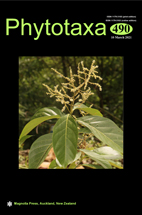Abstract
A new genus in the order Sporolithales (Corallinophycidae, Rhodophyta), Roseapetra farriae gen. et sp. nov. is described, based on material from northern New Zealand. Previously placed in the genus Heydrichia on the basis of morpho-anatomical characters, phylogenetic analyses have shown that this northern New Zealand taxon is not resolved with either Heydrichia or Sporolithon, the two genera currently recognized in this order. Roseapetra displays the key diagnostic features of the order, namely the production of cruciately divided tetrasporangia singly within calcified sporangial compartments. In Roseapetra the tetrasporangia are surrounded by an involucre, and mature tetrasporangia are subtended by up to three stalk cells. The tetrasporangial compartments are shed once spores have been released. Gametangial conceptacles are not shed but become buried, with secondary meristem producing lens-like areas of regrowth. While there are several morpho-anatomical characters that separate Roseapetra and Sporolithon, there are none that can be used to distinguish Roseapetra from Heydrichia: recognition of Roseapetra requires sequence data. Roseapetra farriae is found growing in the low intertidal zone on rocky reefs in shaded, understorey habitats.

